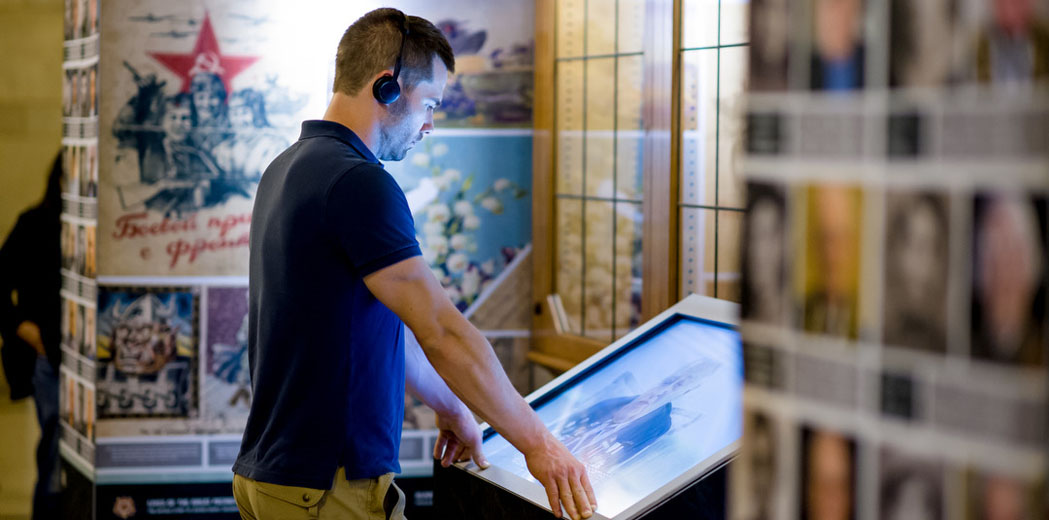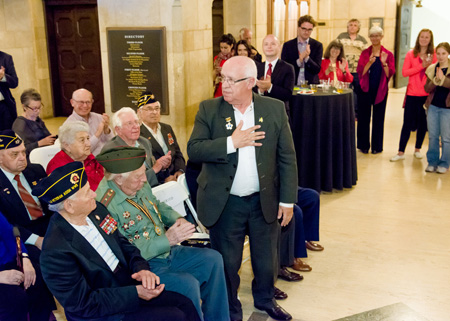Doheny Library and USC Shoah Foundation Host Grand Opening of Blavatnik Archive Exhibit

 A panel discussion and appearances by World War II Soviet veterans marked the grand opening of the Blavatnik Archive Foundation's exhibit at USC Thursday night.
A panel discussion and appearances by World War II Soviet veterans marked the grand opening of the Blavatnik Archive Foundation's exhibit at USC Thursday night.
The exhibit is called Lives of the Great Patriotic War: The Untold Story of Soviet Jewish Soldiers in the Red Army During World War II, and was officially unveiled at a reception on April 24 in Doheny Library room 240. It will be on display in the lobby of Doheny Library for two months.
The exhibit at USC aims to highlight the Jewish soldiers’ unique experience of being targeted for genocide while fighting for their country and contributing to the defeat of Nazi Germany. In print and interactive digital displays, the exhibit will feature war-time diary and letter excerpts, reproductions of archival photographs and documents, and video excerpts from the archive’s oral testimonies. The exhibit follows the chronology of the war, including the events leading up to Germany’s attack on Russia, key battles, and the Soviet victory, as well as the personal experiences of the Jewish soldiers themselves.
The Blavatnik Archive Foundation was founded in 2005 by American industrialist and philanthropist Len Blavatnik – he is executive director along with his brother Alex Blavatnik – with the goal of contributing to a better understanding of the Jewish experience in the Soviet Union from the late 19th to 20th centuries.
At the grand opening on Thursday, a panel discussion with USC Shoah Foundation Visual History Archive curator Crispin Brooks, Robert English, Director, USC School of International Relations and Selma Holo, Director, USC Fisher Museum of Art, provided an overview of the historical events and themes found throughout the exhibit.
English began by outlining the “complex, tragic and brutal” history of Jews in Russia leading up to World War II. After fleeing persecution in England, Spain and France, they enjoyed a rich cultural life in the south and west parts of the country until czars imposed anti-Jewish policies and “life became intolerable,” English said.
After the Bolsheviks took control of Russia, however, Jews found themselves in positions of power for the first time. Some Jews were able to thrive under Bolshevism’s emphasis on urban lifestyles, education, and an end to nationalism, but were also blamed for the country’s problems and targeted in Stalin’s Great Purge.
 Brooks continued with the Holocaust in Russia, quoting from the Red Army’s “Guidelines for the Behavior of Troops” instructing troops that the army was “anti-Bolshevik” and to engage in “ruthless and energetic action” against Bolshevism, Jews and any attempt at resistance. Nazism espoused the idea that Judaism and Bolshevism were a single entity to be destroyed, he said.
Brooks continued with the Holocaust in Russia, quoting from the Red Army’s “Guidelines for the Behavior of Troops” instructing troops that the army was “anti-Bolshevik” and to engage in “ruthless and energetic action” against Bolshevism, Jews and any attempt at resistance. Nazism espoused the idea that Judaism and Bolshevism were a single entity to be destroyed, he said.
The Blavatnik exhibit, Brooks said, helps tell a story that is not widely known. “It combats the idea that Jews went passively to their death and left the fighting to others,” he said. In fact, Jews were significantly overrepresented in the Red Army.
Holo brought a curator’s perspective to the exhibit. She outlined several aspects of curation that demonstrate what the Blavatnik Archive Foundation intended to achieve with this particular exhibit in Doheny Library.
“There is no such thing as an innocent exhibit,” Holo said. “They always have an agenda.”
She pointed out that it is important to notice what’s left out of an exhibit. In this case, she said the curators made the choice to not tell the story of the soldiers defensively, or victimize them, but rather to normalize their experiences.
The exhibit is also clearly designed to be on the move and as versatile as possible, and was intended for an intellectual library audience. Holo encouraged the curators to create a catalog to officially memorialize the exhibit.
A group of Soviet Army veterans featured in the Blavatnik Archive attended the event, proudly wearing their uniforms and medals.
 (Photos by Don Milici)
(Photos by Don Milici)
Like this article? Get our e-newsletter.
Be the first to learn about new articles and personal stories like the one you've just read.